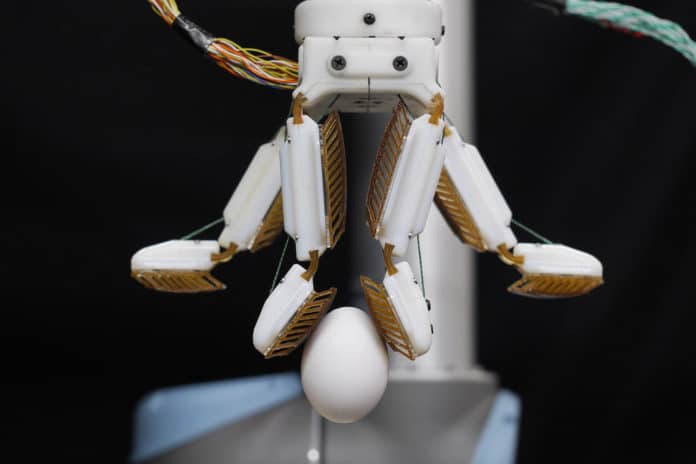One of the major challenges in designing a robotic hand is giving it enough operating flexibility so that it can grip objects of different sizes and weights. A humanoid robotic hand, for example, generally provides more precision and delicacy but is not advantageous when it comes to lifting heavy loads. Unlike human hands, one robotic gripper is unlikely to be able to do both, and a key challenge remains hidden in the middle ground.
Stanford University engineers have developed an experimental new gecko-inspired farmHand that is capable of doing both.
FarmHand benefits from two kinds of biological inspiration. While the multi-jointed fingers are reminiscent of a human hand – albeit a four-fingered one – the fingers are topped with gecko-inspired adhesives. This grippy but not sticky material is based on the structure of gecko toes.
Like gecko’s toes, the gecko adhesive creates a strong hold via microscopic flaps. When in full contact with a surface, these flaps create a Van der Waals force – a weak intermolecular force that results from subtle differences in the positions of electrons on the outsides of molecules. As a result, the adhesives can grip strongly but require little actual force to do so. Also, they don’t feel sticky to the touch or leave a residue behind.
The fuss is that the gecko adhesives must connect with a surface in a particular way in order to activate the Van der Waals force. This is easy enough to control when they are applied smoothly onto a flat surface but much more difficult when a grasp relies on multiple gecko adhesive patches contacting an object at various angles, such as with farmHand.
Below the adhesives, farmHand’s finger pads help address this challenge. They are made of a collapsible rib structure that buckles with even a small amount of force. No matter the location or angle of contact, the ribs consistently buckle so as to ensure equal forces on the adhesive pads and prevent any single one from slipping prematurely. This both minimizes the chances of damage to the item and reduces the likelihood of it slipping out of the hand’s grip.
In their testing, the researchers demonstrated that farmHand is capable of handling a wide variety of items, including raw eggs, bunches of grapes, plates, jugs of liquids, basketballs, and even an angle grinder.
Further improvements to farmHand could come in the form of feedback features that would help users understand how it is gripping and how it could grip better while the hand is in use. The researchers are also considering commercial applications for their work.
